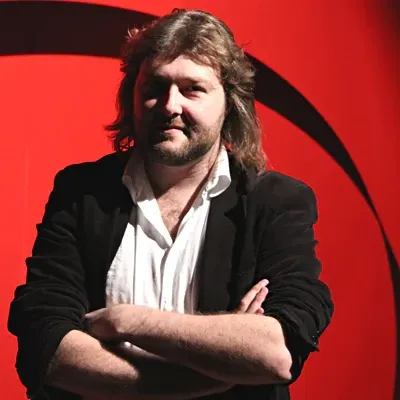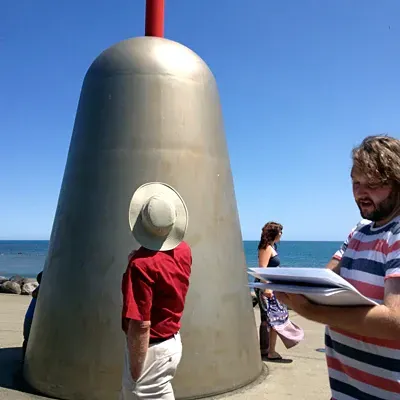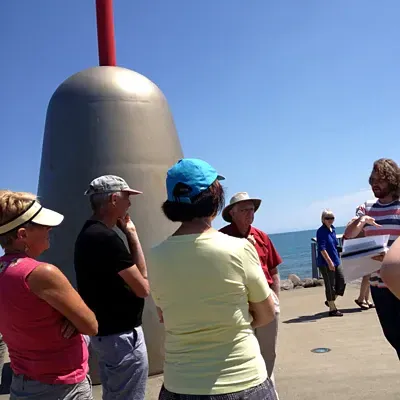TBI Q&A: Paul Brobbel
Written by

As assistant Len Lye curator Paul Brobbel explains ‘tangible motion sculpture’ to the Sunday morning crowd, passersby on New Plymouth's waterfront constantly stop to take photos and gaze up at the Wind Wand.
After the art talk, Paul took The Big Idea editor Cathy Aronson on an impromptu tour of the latest exhibition at Govett-Brewster Art Gallery and chatted about the pending Len Lye Centre.
Back at the desk, we followed up with a TBI QnA to find out more about Paul, his role as assistant curator, the latest on the $10 million centre and Len Lye's connection to Taranaki.
During what hours of the day do you feel most inspired?
Mornings seem to be the most productive. I generally feel the day is wasted if I don’t get up early.
How would a good friend describe your aesthetic or style?
On a good day, clear and precise, on a bad day, terse.
What aspect of your creative practice gives you the biggest thrill?
In most matters it’s the response from the audience. It’s always a pleasure to stand back and watch how visitors interact with an exhibition. I liken exhibitions to parents sending kids off to school, you trust they behave but you never really know. I enjoy talking to visitors in an exhibition one on one – I spend whatever time I can in exhibitions I've worked on.
How does your environment affect your work?
I don't think it does. Not in any positive way. It always seems to be about minimising distractions.
Do you like to look at the big picture or focus on the details?
Generally I prefer details so long as it is serving to moving things forward and for a purpose. I hate long-windedness so I often return to the big picture to get out of a rut.
What's your number one business tip for surviving (and thriving) in the creative industries?
Get over any sense of entitlement you may have. You can jump through all the right hoops – someone else is going to get what you want from time to time.
Which of your projects to date has given you the most satisfaction?
The current Len Lye exhibition at the Govett-Brewster, Len Lye: The New Yorker, is my first exhibition produced without another curator involved. Looking back over the various design iterations, it feels good to see bad ideas coming and going and the development of the exhibition being the result of some good self criticism.
Who or what has inspired you recently?
Robert Fripp, the guitarist from King Crimson, recently retired from making and performing music to devote his time to tackling the injustices of the corporate side of the music industry. I admire his insistence that not everything has to have a price.
Tell us a bit about your background.
I started tertiary study in Computer Science but abandoned that for Classics and English at Auckland University which developed into postgraduate study in Ancient History. Before postgraduate study I began volunteering at Auckland War Memorial Museum, working with collections. After completing the MA I followed with postgraduate Museum Studies, again at Auckland. After that I had several collection management roles working with photographic collections including Te Papa Tongarewa Museum of New Zealand.
Describe your role as Assistant Curator Len Lye for Govett-Brewster
It’s a big mix of things from managing the Len Lye Foundation Collection here at the Govett-Brewster, organising the loan of Lye’s works to other galleries and institutions, assisting with research for the Foundation and for scholars, developing Len Lye exhibitions for the Govett-Brewster and other New Zealand venues. The variety of media in Lye’s oeuvre gives me the opportunity to get to grips with very different fields such as cinema, sculpture, painting, not to mention Lye’s prolific writings. It means I work alongside many specialists from beyond the gallery, particularly our colleagues at the New Zealand Film Archive (who care for Lye’s films) and a number of engineers working with Lye’s kinetic sculpture.
Tell us about the exhibition Len Lye: The New Yorker
I wanted to look at a particular period of Lye’s life between his move in 1944 from London to New York and his emergence as a kinetic sculptor in the early 1960s. Those 15 or so years are marked by some of Lye’s greatest achievements, such as his film Free Radicals (1958) and his sculptural performance at New York’s Museum of Modern Art (1961). There were also personal and professional circumstances that make those years interesting and, coupled with the emergence of New York the new centre of the art world following WWII, it felt like good period to consider in detail. For such a chronologically restricted premise, the show highlights the breadth of Lye’s work. Many of Lye’s well known works feature but we’ve worked hard to dig deeper, showcasing ephemera from Lye’s archive and screening Lye’s film Fountain of Hope (1959) for the first time.
What’s the latest with the Len Lye Centre?
As of September 2012 the New Plymouth District Council has secured the $10 million required to build the Len Lye Centre which will operate as a combined facility with the Govett-Brewster Art Gallery. We are currently in the tendering process with construction expected to commence in early 2013 and a targeted opening date of early 2015.
What’s Len Lye’s connection to Taranaki?
Lye has connections to various places in New Zealand - he was born in Christchurch for example - but having spent most of his career away from New Zealand, it was through New Plymouth that he reconnected to his homeland. In 1977 the Govett-Brewster held the exhibition Kinetic Works, formally re-introducing Lye and his work to New Zealand. The larger, metropolitan galleries had not been interested in Lye but the recently founded Govett-Brewster was keen to support the efforts of a number of energetic Lye supporters and bring Lye back home for a show. Importantly, Lye was to produce several new and larger versions of his sculpture for Kinetic Works and local engineer and Govett-Brewster supporter John Matthews worked with Lye on their design and construction.
Lye appreciated all that energy, talent and compatibility. He subsequently established the Len Lye Foundation in New Zealand to administer his affairs with the Govett-Brewster entrusted to care for his works. I like to think the nature of the relationship between Lye and New Plymouth was a professional one that grew into something more personal for Lye.
Why do you think it’s important to have a dedicated centre?
Lye is an important figure but not a well-known one. We can express the facts and significance of Lye's achievements as much as we want but the only means to really communicate why Lye’s work is so special is to have people experience it – and experience the full force of it. Many people have seen Lye’s works on display at the Govett-Brewster over the last thirty-odd years but many more have missed out as a permanent display of Lye’s work has been impractical. A dedicated Len Lye Centre improves our access to Lye’s work but also sets a stronger foundation from which we can care for the work and promote Lye’s achievements internationally.
If you could go back and choose a completely different career path to the one you've chosen, what would it be?
Honestly, I wouldn’t do things so differently, just better, but I think being a computer game designer was the most likely career I was interested in when I left school.
What place is always with you, wherever you go?
I’m feeling less and less sentimental but I always think fondly of certain places I visited as a child – Skipton and Ripon in Yorkshire. Le Touquet in France. I’ll go out of my way to see those places again.
What's the best way to listen to music, and why?
The same way you read a book – no distractions. I don’t believe in background music and when I do something while playing music the music always wins.
You are given a piece of string, a stick and some fabric. What do you make?
A toy to entertain a cat or, with a sturdy stick, a Huck Finn style hobo-stick.
What's the best stress relief advice you've ever been given?
From the Simpsons: "To alcohol! The cause of – and solution to – all of life's problems”
What’s great about today?
In a literal sense, today has been an effortlessly productive day. Beyond that I wouldn’t want to cast judgement on the larger state of things.
What’s your big idea for 2013?
Exploring the multitude of opportunities relating to the Len Lye Centre as well as a couple of Lye exhibitions at other New Zealand galleries – first up is Len Lye: Kaleidoscope at City Gallery Wellington from 2 Mar - 26 May 2013.

